We may earn revenue from the products available on this page and participate in affiliate programs. Learn More ›
When considering whether to install a pocket door versus a regular door, it’s important to understand the differences between the two. A pocket door differs from a standard hinged door that opens by swinging back and forth. Instead, a pocket door slides, via rollers on an overhead track, into a “pocket” in the wall on either side of it.
When it’s fully open, the pocket door completely disappears. This design eliminates the need for the clearance that standard hinged doors require to operate. Pocket doors were very popular in the Victorian era as people searched for stylish space-saving ways to add doors to libraries, dining rooms, and living rooms. Though not as popular as standard swinging doors, today pocket doors are an excellent way to add privacy and elegance to a space without the clearance required for a traditional door.
The Pros and Cons of Pocket Doors
Pocket doors are seeing a bit of a resurgence, particularly in smaller living quarters such as condominiums and townhouses where a single square foot can’t be wasted. These doors do have their drawbacks, however, and are not the right solutions for every space. Keep these advantages and disadvantages in mind if you’re thinking about installing this type of door:
Advantages of Pocket Doors
- Pocket doors save valuable floor space by eliminating the room you need for traditional doors to swing open.
- Because a pocket door slides into the wall, you need to have enough clearance in the wall framing for the door(s) to accommodate the door when it’s pushed into the wall pocket. What’s more, there cannot be any interior obstacles—no light switches, electrical outlets, or plumbing—on that stretch of wall.
- Pocket doors hang from a track that is mounted to the ceiling, and do not require a floor track. This allows them to create boundaries between rooms without installing a threshold or floor track that breaks up the flow from one room to the next.
Disadvantages of Pocket Doors
- Pocket door hardware is fairly small since it, too, must be able to clear the framing in the wall. To close the door, you insert a single finger into a small retractable latch located on the door’s exposed edge, and pull the door closed. This manual maneuver can be difficult for some people.
- There are lockable pocket doors; however, the design of the door can make it difficult to manipulate these locks. Double pocket door privacy lock sets exist, but they are not common and can be expensive.
- The tracks and hardware in a pocket door frame are largely hidden inside the wall. If they need repair or replacement, access can be very difficult. Double pocket door hardware uses a longer track that holds two separate door panels, which can make them even harder to repair.
RELATED: Standard Door Size 101: Important Measurements All Homeowners Should Know
Types of Pocket Doors
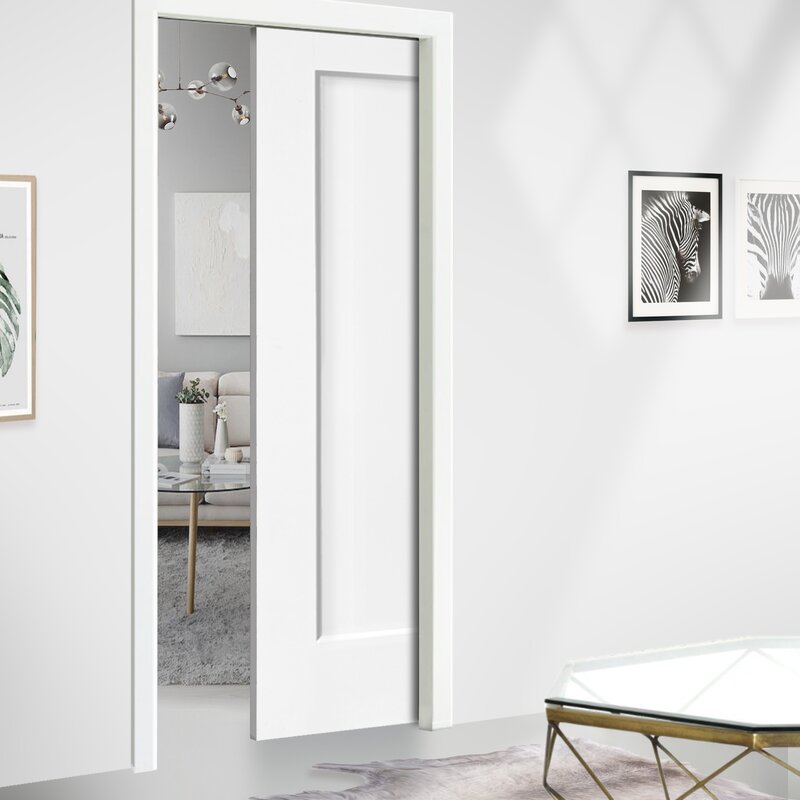
The most common pocket door consists of a single, 36-inch wide solid panel that slides on a track into the wall. Although this single pocket door may be the most common type, it isn’t the only style. There are also double pocket doors for wider entryways as well as sophisticated pocket French doors.
Double Pocket Doors
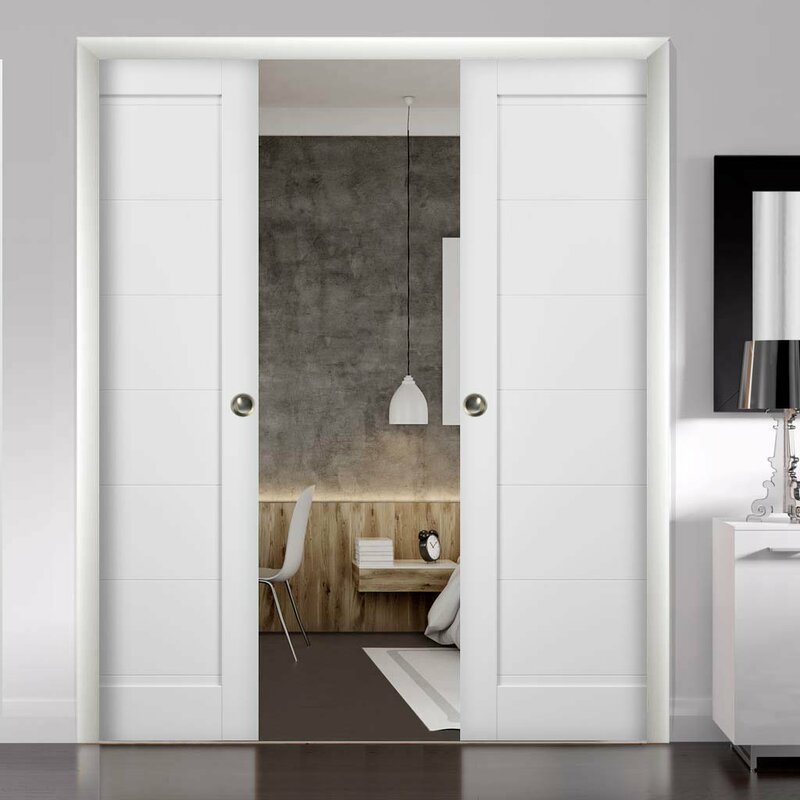
Double pocket doors function in the same way as single pocket doors, only with two doors instead of one. With a double pocket door, the two doors slide into pockets in the door openings of adjacent walls. To close them, the doors extend from the wall pockets to meet in the middle of the doorway in the same manner as elevator doors.
Double pocket door openings accommodate wider entryways to dining rooms and living rooms that do not offer enough clearance inside the room for swinging French doors. Double pocket doors come in various styles including solid wood as well as glass-paned doors. Since double pocket doors require two door pockets, they’ll only work for entryways with ample wall space (and no electrical outlets or light switches) on both sides.
Pocket French Doors
French pocket doors are similar to double pocket doors in that they use two door panels that extend into the wall on either side when open, and then meet together in the middle of the entryway to close. Unlike double pocket doors that cover broad entryways, a French pocket door fits a standard 36-inch wide doorway. This type of pocket door can be constructed with solid panels or glass panes.
Pocket French doors are a great way to add elegance to an entryway. They’re also a good solution for homeowners who, for example, want to install a 36-inch pocket door but don’t have enough wall space on one side to accommodate the stowed door. Because French pocket door panels are narrower than that of a standard pocket door, a homeowner would need a little more than 18 inches of wall space on both sides of the entryway, rather than a full 36 inches on one side.
RELATED: How to Frost Glass for Privacy
What to Know About Installing Pocket Doors
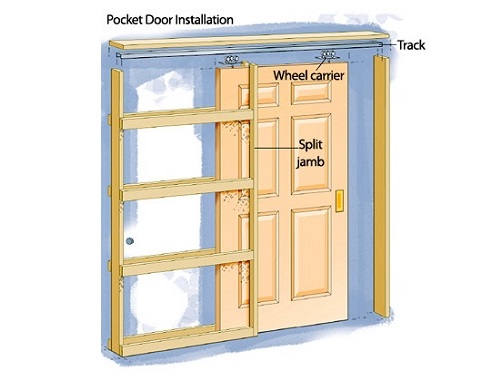
Before embarking on a pocket door installation, it’s important to understand what the job requires.
Installing a pocket door involves a fair amount of renovation to the wall itself. First, you’ll need to expose the wall framing by removing drywall on both sides of the wall. Then you’ll need to cut away the wall studs to create an open pocket into which the door can slide when in the open position. Since you’ll be removing wall studs, you’ll need to install a header above the pocket door that will transfer the load that the wall carries to the remaining studs around the pocket door.
Once the door is installed, you’ll need to replace the drywall you removed with new drywall, then mud and repaint the wall before installing new door trim.
Remember, walls with electrical wiring or plumbing running through them are not suitable for a pocket door. You also won’t be able to install a pocket door in a wall that isn’t at least twice the width of the door.
RELATED: The Best Barn Doors You Can Get
Final Thoughts
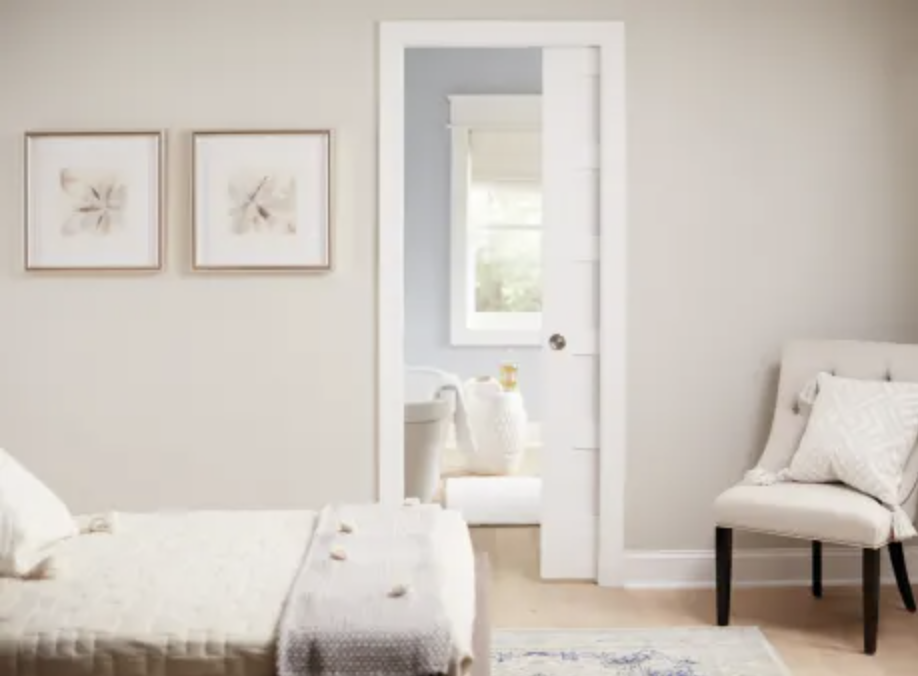
Adding a pocket door to an open entryway or replacing an existing door with a pocket door is a great way to add privacy and elegance to a living area while saving space. Installing pocket doors is a doable DIY project for some homeowners, but before you begin tearing into drywall make sure you’re comfortable with the demolition, reframing, and finishing work that pocket door installation requires. By following the tips in this article, you can trade out a traditional door with a sophisticated and elegant pocket door.
FAQs About Pocket Doors
If you’re wondering whether a pocket door will work for that dining room entryway or sitting room in your home, read on for answers to some of the most common questions about pocket door installation.
Q: Can any door be a pocket door?
Many standard doors can be converted into a pocket door as long as the measurements fit the opening. Keep in mind that the door must be the right thickness for the rough opening and the door should not be pre-drilled for standard door locksets and hinges.
Q: Do pocket doors require thicker walls?
A pocket door is designed to replace the wall studs that create the framing for the wall, therefore a wall for a pocket door will be the same thickness as any other interior wall of the home.
Q: Can you put a pocket door in an existing wall?
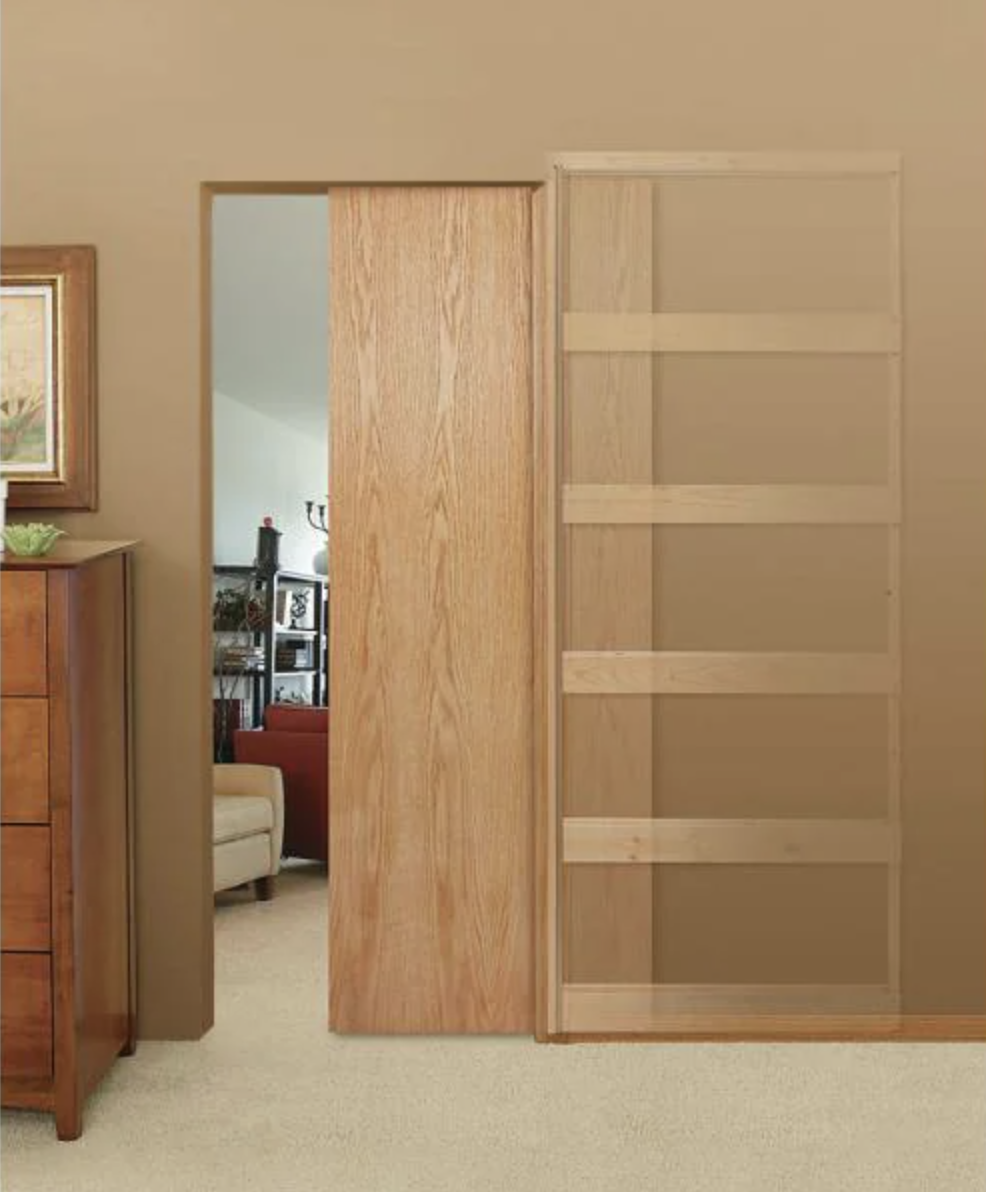
It is possible to put a pocket door in an existing wall. Keep in mind that not every doorway can be turned into a pocket door. The doorway must be twice as wide as the door to allow for enough space for the door to fully slide into the wall when open.
Q: Are pocket doors hard to install?
Installing a pocket door in an existing wall is not a simple project. Making this conversion requires you to remove the drywall to reveal the entire wall, and then reframe the wall to create space for the track and the door. Once installed, you’ll need to reinstall new drywall, seal the gaps with mudding, then prime and paint it before adding trim.
Q: Can you put a pocket door anywhere?
You can install a pocket door in any interior doorway of the home that has enough wall space to accommodate the door. First, be sure to check for plumbing or electrical inside the pocket space, however. The best place for a pocket door is in rooms where there isn’t enough clearance for a traditional swinging door.


